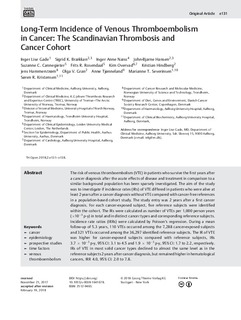Long-Term Incidence of Venous Thromboembolism in Cancer: The Scandinavian Thrombosis and Cancer Cohort
| dc.contributor.author | Gade, Inger Lise | |
| dc.contributor.author | Brækkan, Sigrid Kufaas | |
| dc.contributor.author | Næss, Inger Anne | |
| dc.contributor.author | Hansen, John-Bjarne | |
| dc.contributor.author | Cannegieter, Suzanne C. | |
| dc.contributor.author | Rosendaal, Frits Richard | |
| dc.contributor.author | Overvad, Kim | |
| dc.contributor.author | Hindberg, Kristian | |
| dc.contributor.author | Hammerstrøm, Jens | |
| dc.contributor.author | Gran, Olga Vikhammer | |
| dc.contributor.author | Tjønneland, Anne | |
| dc.contributor.author | Severinsen, Marianne T. | |
| dc.contributor.author | Kristensen, Søren R | |
| dc.date.accessioned | 2019-04-01T09:03:24Z | |
| dc.date.available | 2019-04-01T09:03:24Z | |
| dc.date.created | 2018-04-10T10:28:27Z | |
| dc.date.issued | 2018 | |
| dc.identifier.citation | TH Open. 2018, 2 (2), . | nb_NO |
| dc.identifier.issn | 2512-9465 | |
| dc.identifier.uri | http://hdl.handle.net/11250/2592639 | |
| dc.description.abstract | The risk of venous thromboembolism (VTE) in patients who survive the first years after a cancer diagnosis after the acute effects of disease and treatment in comparison to a similar background population has been sparsely investigated. The aim of the study was to investigate if incidence rates (IRs) of VTE differed in patients who were alive at least 2 years after a cancer diagnosis without VTE compared with cancer-free references in a population-based cohort study. The study entry was 2 years after a first cancer diagnosis. For each cancer-exposed subject, five reference subjects were identified within the cohort. The IRs were calculated as number of VTEs per 1,000 person years (×10−3 p-y) in total and in distinct cancer types and corresponding reference subjects. Incidence rate ratios (IRRs) were calculated by Poisson's regression. During a mean follow-up of 5.3 years, 110 VTEs occurred among the 7,288 cancer-exposed subjects and 321 VTEs occurred among the 36,297 identified reference subjects. The IR of VTE was higher for cancer-exposed subjects compared with reference subjects, IRs 3.7 × 10−3 p-y, 95% CI: 3.1 to 4.5 and 1.9 × 10−3 p-y, 95% CI: 1.7 to 2.2, respectively. IRs of VTE in most solid cancer types declined to almost the same level as in the reference subjects 2 years after cancer diagnosis, but remained higher in hematological cancers, IRR 4.0, 95% CI: 2.0 to 7.8. | nb_NO |
| dc.language.iso | eng | nb_NO |
| dc.publisher | Thieme | nb_NO |
| dc.rights | Navngivelse 4.0 Internasjonal | * |
| dc.rights.uri | http://creativecommons.org/licenses/by/4.0/deed.no | * |
| dc.title | Long-Term Incidence of Venous Thromboembolism in Cancer: The Scandinavian Thrombosis and Cancer Cohort | nb_NO |
| dc.type | Journal article | nb_NO |
| dc.type | Peer reviewed | nb_NO |
| dc.description.version | publishedVersion | nb_NO |
| dc.source.pagenumber | 8 | nb_NO |
| dc.source.volume | 2 | nb_NO |
| dc.source.journal | TH Open | nb_NO |
| dc.source.issue | 2 | nb_NO |
| dc.identifier.doi | 10.1055/s-0038-1641678 | |
| dc.identifier.cristin | 1578532 | |
| dc.description.localcode | 2018 Open Access. CC-BY 4.0 | nb_NO |
| cristin.unitcode | 194,65,15,0 | |
| cristin.unitname | Institutt for klinisk og molekylær medisin | |
| cristin.ispublished | true | |
| cristin.fulltext | original | |
| cristin.qualitycode | 1 |

